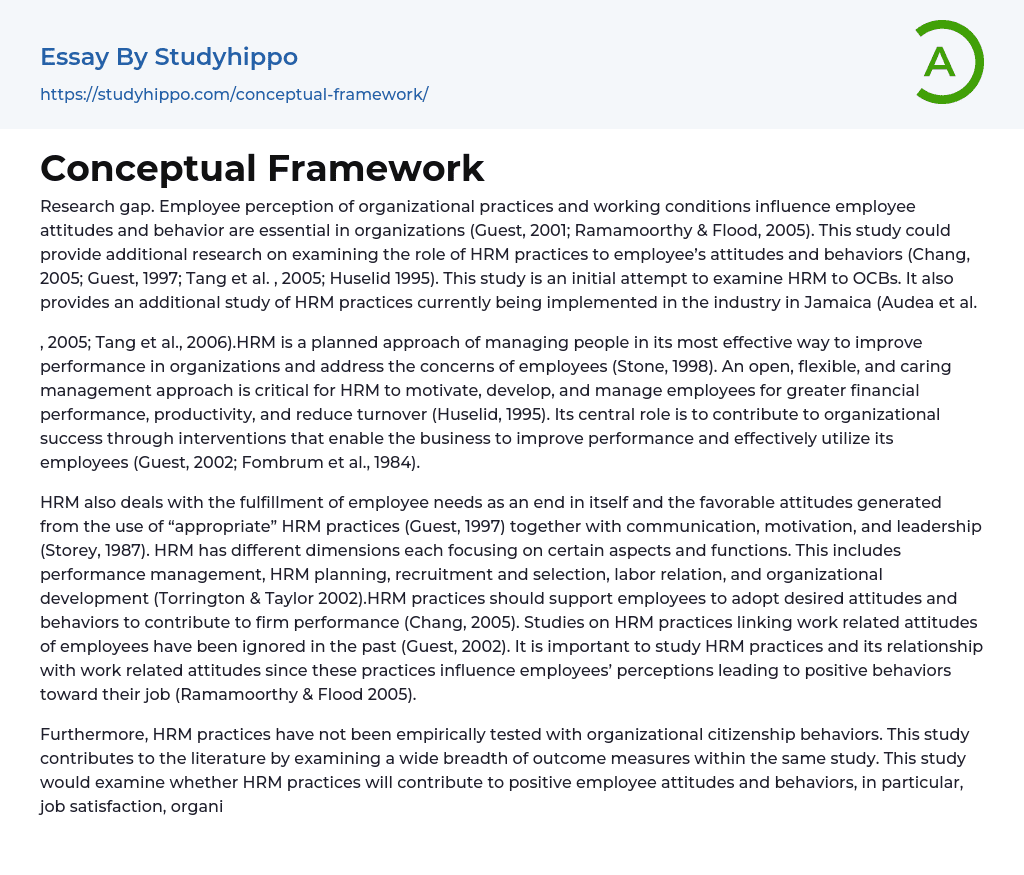Research gap. Employee perception of organizational practices and working conditions influence employee attitudes and behavior are essential in organizations (Guest, 2001; Ramamoorthy & Flood, 2005). This study could provide additional research on examining the role of HRM practices to employee’s attitudes and behaviors (Chang, 2005; Guest, 1997; Tang et al. , 2005; Huselid 1995). This study is an initial attempt to examine HRM to OCBs. It also provides an additional study of HRM practices currently being implemented in the industry in Jamaica (Audea et al.
, 2005; Tang et al., 2006).HRM is a planned approach of managing people in its most effective way to improve performance in organizations and address the concerns of employees (Stone, 1998). An open, flexible, and caring management approach is critical for HRM to motivate, develop, and manage employees for greater financial performance, productivity, and reduce turnover (Huselid
..., 1995). Its central role is to contribute to organizational success through interventions that enable the business to improve performance and effectively utilize its employees (Guest, 2002; Fombrum et al., 1984).
HRM also deals with the fulfillment of employee needs as an end in itself and the favorable attitudes generated from the use of “appropriate” HRM practices (Guest, 1997) together with communication, motivation, and leadership (Storey, 1987). HRM has different dimensions each focusing on certain aspects and functions. This includes performance management, HRM planning, recruitment and selection, labor relation, and organizational development (Torrington & Taylor 2002).HRM practices should support employees to adopt desired attitudes and behaviors to contribute to firm performance (Chang, 2005). Studies on HRM practices linking work related attitudes of employees have been ignored in the past (Guest, 2002). It is important to
study HRM practices and its relationship with work related attitudes since these practices influence employees’ perceptions leading to positive behaviors toward their job (Ramamoorthy & Flood 2005).
Furthermore, HRM practices have not been empirically tested with organizational citizenship behaviors. This study contributes to the literature by examining a wide breadth of outcome measures within the same study. This study would examine whether HRM practices will contribute to positive employee attitudes and behaviors, in particular, job satisfaction, organizational trust, and organizational citizenship behavior (see Figure 1), Using the method proposed by Chang (2005), this study would group six HRM practices as a bundle.These HRM practices are internal career opportunities, training, results-oriented appraisal, employment security, participation, and job description. This bundled HRM practices are consistently considered strategic compared to other set of HRM practices (Delery & Doty, 1996) as a result the researcher adapted the model of Delery & Doty (1996).
This set of HRM practices can produce positive synergy as a set of post-hire HRM practices (Huselid, 1995).Synergy refers to an action of two or more substances that result in an effect that is different from the individual summation of the substances (Robbins, 2005). A bundle of interrelated practices provide several ways for workers to acquire skills and multiple incentives to boost motivation. The combined practices shape the pattern of behaviors between and among managers and employees (MacDuffie, 1995; Guest, 2004). Furthermore, employees perceive HRM practices as an exclusive and single practice rather than separate and diverse fields (Chang, 2005).
HRM produces complimentary and interrelated mechanisms that provide a link on building employee attitudes and behaviors (Bowen & Ostroff, 2004). This would result to the alignment of each
HRM practice producing synergy and increased productivity and corporate financial performance (Huselid, 1995). Employee attitudes are one component and play a key role in many conceptualizations of organizational effectiveness. Thus, it is important to determine whether employee attitudes are related to perceptions to HRM practices (Kanter & Brinkerhoff, 1981).
- Academia essays
- Higher Education essays
- Language Learning essays
- Studying Business essays
- Education System essays
- Study essays
- First Day of School essays
- Scholarship essays
- Pedagogy essays
- Curriculum essays
- Coursework essays
- Studying Abroad essays
- Philosophy of Education essays
- Purpose of Education essays
- Brainstorming essays
- Educational Goals essays
- Importance Of College Education essays
- Brown V Board of Education essays
- The Importance Of Higher Education essays
- Online Education Vs Traditional Education essays
- Academic And Career Goals essays
- Academic Integrity essays
- Brown Vs Board Of Education essays
- Distance learning essays
- Technology in Education essays
- Vocabulary essays
- Writing Experience essays
- Importance of Education essays
- Early Childhood Education essays
- Academic Degree essays
- Academic Dishonesty essays
- School Uniform essays
- Academic writing essays
- Cheating essays
- Bachelor's Degree essays
- MBA essays
- College Life essays
- Grade essays
- Diploma essays
- Phonology essays
- Sentence essays
- Filipino Language essays
- Pragmatics essays
- Millennium Development Goals essays
- History Of Education essays
- Graduate School essays
- Middle School essays
- School essays
- Special Education essays
- University essays




